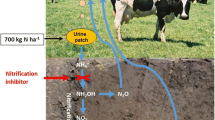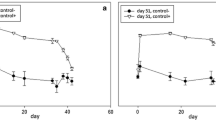Abstract
Purpose
Nitrous oxide (N2O) is a potent greenhouse gas and, in grazed grassland systems where animals graze outdoor pastures, most of the N2O is emitted from animal urine nitrogen (N) deposited during grazing. Recently, ammonia-oxidizing archaea (AOA) were found to be present in large numbers in soils as well in the ocean, suggesting a potentially important role for AOA, in addition to ammonia-oxidizing bacteria (AOB), in the nitrogen cycle. The relationship between N2O emissions and AOB and AOA populations is unknown. The objective of this study was to determine the quantitative relationship between N2O emissions and AOB and AOA populations in nitrogen-rich grassland soils.
Materials and methods
We determined N2O emissions and the abundance and activity of AOB and AOA in four different soils as affected by the applications of animal urine N and dicyandiamide (DCD) as a nitrification inhibitor. Relationships were then determined between N2O emissions and the AOB and AOA populations.
Results and discussion
Total N2O emissions from the urine N applied at 1,000 kg N ha−1 varied significantly in these soils, from 13.9 to 39.8 kg N2O-N ha−1. The DCD treatment reduced these N2O emissions to between 2.8 and 15.3 kg N2O-N ha−1. The average emission factor of the urine N (EF3) was 2.2% and this was decreased to 0.8%, representing a 64% reduction. Total N2O emissions were significantly related to the amoA gene copy numbers of the AOB population and to the amount of nitrate-N in the soil, but not related to the abundance of AOA.
Conclusions
These results demonstrate that the N2O flux is mainly associated with the dynamics of the AOB population rather than the AOA in these nitrogen-rich grassland soils, and therefore, it is the AOB that should be the target of inhibition when mitigating N2O emissions using nitrification inhibitors.






Similar content being viewed by others
References
Amberger A (1989) Research on dicyandiamide as a nitrification inhibitor and future outlook. Commun Soil Sci Plant Anal 20:1933–1955
Baggs EM, Richter M, Hartwig UA, Cadisch G (2003) Nitrous oxide emissions from grass swards during the eighth year of elevated atmospheric pCO2 (Swiss FACE). Glob Chang Biol 9:1214–1222
Barton L, de Klein CAM, Sherlock RR (2000) N2O emissions from livestock urine applied to pasture. Client report prepared for the Ministry for the Environment and the Ministry of Agriculture and Forestry. Wellington, New Zealand
Bolan NS, Saggar S, Luo J, Bhandral R, Singh J (2004) Gaseous emissions of nitrogen from grazed pastures: processes, measurements and modelling, environmental implications, and mitigation. Adv Agron 84:37–120
Cameron KC, Smith NP, McLay CDA, Fraser PM, McPherson RJ, Harrison DF, Harbottle P (1992) Lysimeters without edge-flow: an improved design and sampling procedure. Soil Sci Soc Am J 56:1625–1628
De Klein CAM, Barton L, Sherlock RR, Li Z, Littlejohn RP (2003) Estimating a nitrous oxide emission factor for animal urine from some New Zealand pastoral soils. Aust J Soil Res 41:381–399
Di HJ, Cameron KC (2002a) Nitrate leaching in temperate agroecosystems: sources, factors and mitigating strategies. Nutr Cycl Agroecosyst 46:237–256
Di HJ, Cameron KC (2002b) The use of a nitrification inhibitor, dicyandiamide (DCD), to reduce nitrate leaching and nitrous oxide emissions in a simulated grazed and irrigated grassland. Soil Use Manage 18:395–403
Di HJ, Cameron KC, Sherlock RR (2007) Comparison of the effectiveness of a nitrification inhibitor, dicyandiamide (DCD), in reducing nitrous oxide emissions in four different soils under different climatic and management conditions. Soil Use Manage 23:1–9
Di HJ, Cameron KC, Shen JP, Winefield CS, O'Callaghan M, Bowatte S, He JZ (2009) Nitrification driven by bacteria and not archaea in nitrogen-rich grassland soils. Nat Geosci 2:621–624
Dobbie KE, Smith KA (2003) Nitrous oxide emission factors for agricultural soils in Great Britain: the impact of soil water-filled pore space and other controlling variables. Glob Chang Biol 9:204–218
Francis CA, Roberts KJ, Beman JM, Santoro AE, Oakley BB (2005) Ubiquity and diversity of ammonia-oxidizing archaea in water columns and sediments of the ocean. Proc Natl Acad Sci U S A 102:14683–14688
Hatch D, Trindal H, Cardenas L, Carneiro J, Hawkins J, Scholefield D, Chadwick D (2005) Laboratory study of the effects of two nitrification inhibitors on greenhouse gas emissions from a slurry-treated arable soil: impact of diurnal temperature cycle. Biol Fertil Soils 41:225–232
Haynes RJ, Williams PH (1993) Nutrient cycling and soil fertility in the grazed pasture ecosystem. Adv Agron 46:119–199
He JZ, Shen JP, Zhang LM, Zhu YG, Zheng YM, Xu MG, Di HJ (2007) Quantitative analyses of the abundance and composition of ammonia-oxidizing bacteria and ammonia-oxidizing archaea of a Chinese upland red soil under long-term fertilization practices. Environ Microbiol 9:2364–2374
Hewitt AE (1998) New Zealand soil classification, 2nd edn. Manaaki Whenua Press, Lincoln
Hutchinson GL, Mosier AR (1981) Improved soil cover method for field measurement of nitrous oxide fluxes. Soil Sci Soc Am J 45:311–316
IPCC (1995) Climate change 1995: the science of climate change. Contribution of Working Group 1 to the Second Assessment of the Intergovernmental Panel on Climate Change. Cambridge University Press, UK
Könneke M, Bernhard AE, de la Torre JR, Walker CB, Waterbury JB, Stahl DA (2005) Isolation of an autotrophic ammonia-oxidizing marine archaeon. Nature 437:543–546
Kowalchuk GA, Stephen JR (2001) Ammonia-oxidizing bacteria: a model for molecular microbial ecology. Annu Rev Microbiol 55:485–529
Leininger S, Urich T, Schloter M, Schwark L, Qi J, Nicol GW, Prosser JI, Schuster SC, Schleper C (2006) Archaea predominate among ammonia-oxidizing prokaryotes in soils. Nature 442:806–809
Machefert SE, Dise NB, Goulding KWT, Whitehead PG (2002) Nitrous oxide emission from a range of land uses across Europe. Hydrol Earth Syst Sci 6:325–337
Mahmood S, Prosser JI (2006) The influence of synthetic sheep urine on ammonia-oxidizing bacterial communities in grassland soil. FEMS Microbiol Ecol 56:444–454
Prosser JI, Nicol GW (2008) Relative contributions of archaea and bacteria to aerobic ammonia oxidation in the environment. Environ Microbiol 10:2931–2941
Purkhold U, Pommerening-Röser A, Juretschko S, Schmid MC, Koops HJ, Wagner M (2000) Phylogeny of all recognized species of ammonia oxidizers based on comparative 16S rRNA and amoA sequence analysis: implications for molecular diversity surveys. Appl Environ Microbiol 66:5368–5382
Rotthauwe JH, Witzel KP, Liesack W (1997) The ammonia monooxygenase structural gene amoA as a functional marker: molecular fine-scale analysis of natural ammonia-oxidizing populations. Appl Environ Microbiol 63:4704–4712
Schauss K, Focks A, Leininger S, Kotzerke A, Heuer H, Thiele-Bruhn S, Sharma S, Wilke BM, Matthies M, Smalla K, Munch JC, Amelung W, Kaupenjohann M, Schloter M, Schleper C (2009) Dynamics of functional relevance of ammonia-oxidizing archaea in two agricultural soils. Environ Microbiol 11:446–456
Soil Survey Staff (1998) Keys to soil taxonomy, 8th edn. United States Department of Agriculture, Washington
Valentine DL (2007) Adaptation to energy stress dictate the ecology and evolution of the Archaea. Nat Rev Microbiol 5:316–323
Venter JC, Remington K, Heidelberg JF, Halpern AL, Rusch D (2004) Environmental genome shotgun sequencing of the Sargasso Sea. Science 3–4:66–74
Wuchter C, Abbas B, Coolen MJL, Herfort L, van Bleijswijk J, Timmers P, Strous M, Teira E, Herndl GJ, Middleburge JJ, Schouten S, Sinninghe Damste JS (2006) Archaeal nitrification in the ocean. Proc Natl Acad Sci U S A 103:12317–12322
Acknowledgments
We thank the New Zealand Ministry of Agriculture and Fisheries, the Pastoral 21 Consortium, the Foundation for Research, Science and Technology (FRST), and the Ravensdown Fertiliser Co-Operative Ltd. for funding the research and Trevor Hendry, Steve Moore, Neil Smith, Nigel Beale, Carole Barlow, Jie Lei, and Roger Atkinson for the technical assistance.
Author information
Authors and Affiliations
Corresponding author
Additional information
Responsible editor: Caixian Tang.
Rights and permissions
About this article
Cite this article
Di, H.J., Cameron, K.C., Sherlock, R.R. et al. Nitrous oxide emissions from grazed grassland as affected by a nitrification inhibitor, dicyandiamide, and relationships with ammonia-oxidizing bacteria and archaea. J Soils Sediments 10, 943–954 (2010). https://doi.org/10.1007/s11368-009-0174-x
Received:
Accepted:
Published:
Issue Date:
DOI: https://doi.org/10.1007/s11368-009-0174-x




